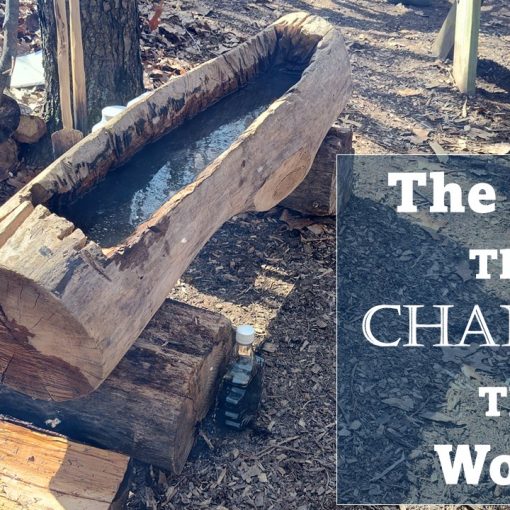“That historical sign says, ‘Ice Cream Sundae.’ ” I noticed as Chuck and I drove through Two Rivers, Wisconsin. “Birthplace of the Ice Cream Sundae” banners had flanked the streets. Curious minds had wanted to learn all about this “Ice Cream Sundae” situation. So, we spun the Jeep around to investigate this Lake Michigan town’s notable qualities. This ‘birthplace’ designation has actually brewed a battle against Ithaca, New York. Check out this story before your ice cream melts!
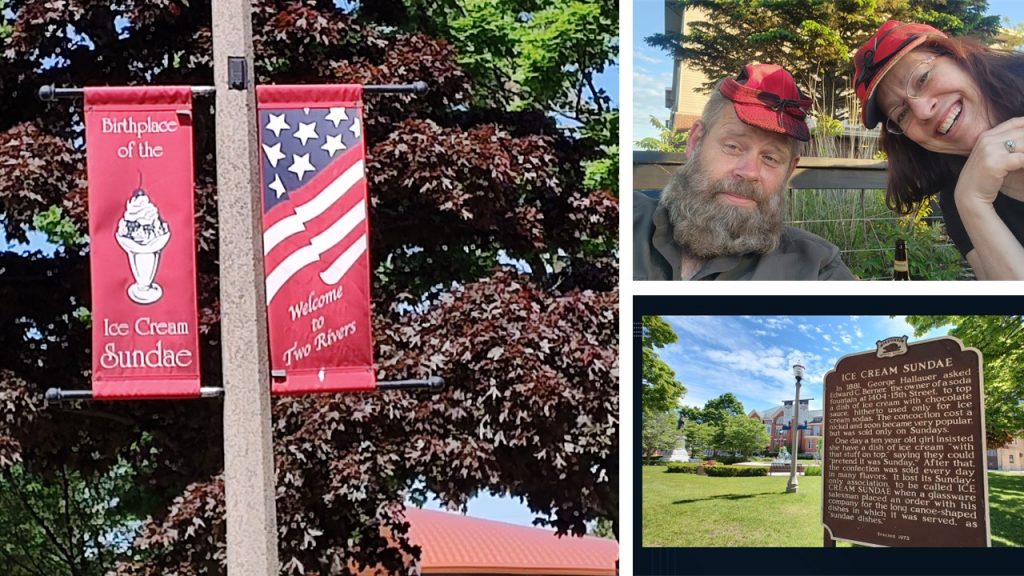
As we rounded the block, a mural of an ice cream shop came into view, “Ed Berner’s Ice Cream Parlor.” I loved how this town has embraced their charming history!
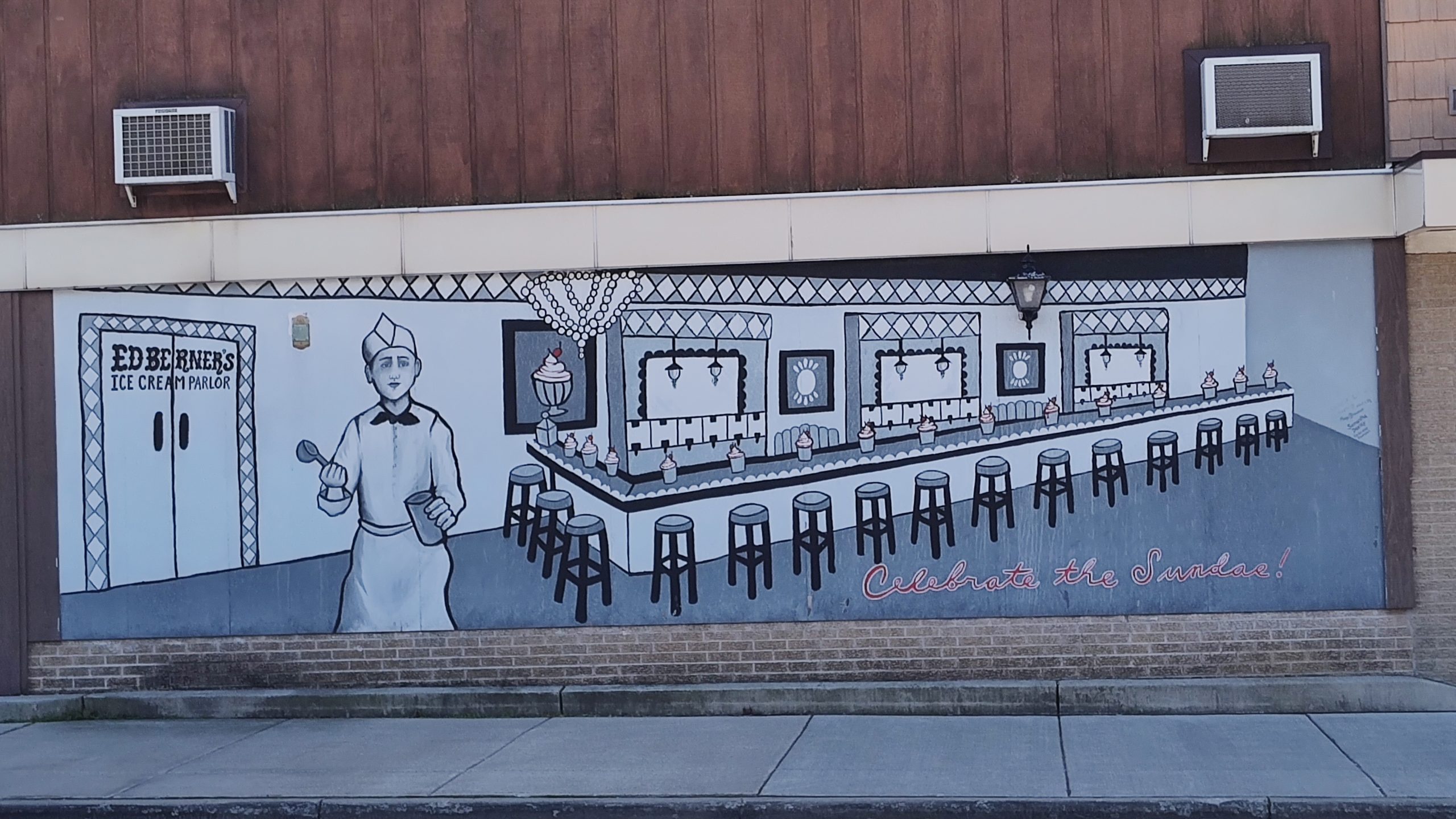
under the inspiration and direction of their student teacher, Samantha Deeley.
The “Ice Cream Sundae” Historical Marker
Then Chuck and I approached the official historical marker which had explained the beginning of the ice cream sundae.
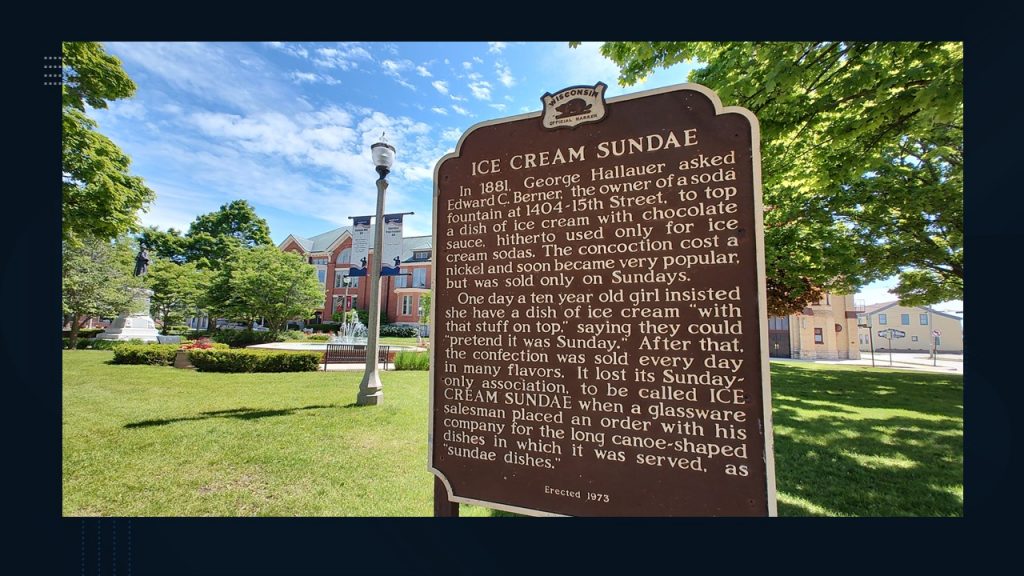
as the “Birthplace of the Ice Cream Sundae.”
The First Ice Cream Sundae
It had been on a Sunday in 1881 when George Hallauer had entered Ed Berner’s Ice Cream Parlor and asked for an ice cream soda. However with the National “Blue Laws” in place, Ed Berner didn’t feel comfortable making a soda on this holy day of the week. You see, “work, travel and recreation” had been banned on Sundays in our Christian nation. Consuming alcohol and soda had been forbidden. At that time these “Blue Laws” had been falling out of favor, since the Civil War, but many still observed the tradition.
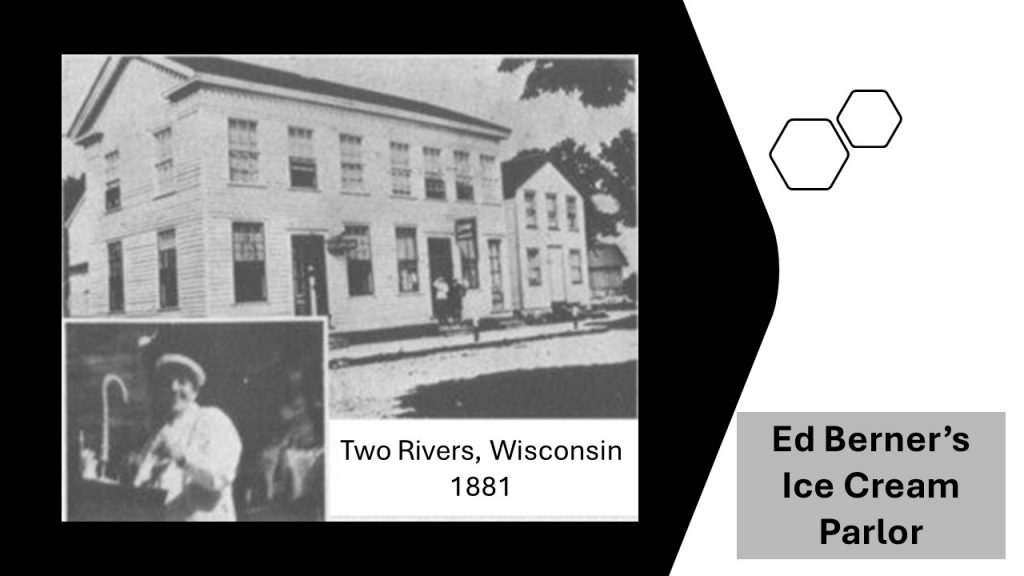
Ed Berner’s solution was to serve a scoop of ice cream with a drizzle of the chocolate syrup over the top. The syrup had been traditionally used in mixing an ice cream soda. So, without using soda water, this five cent ice cream dish had still been legal and quickly grew in popularity as a ‘Sunday treat.’
Weeks later a ten year old girl had come to Berner’s Ice Cream Parlor and had asked for “a dish of ice cream with the stuff on the top.” Berner hesitated and she added with a smile, “We can pretend it’s Sunday.” Soon, this concoction, a Sunday Treat, was being served in many flavors any day of the week and referred to as a “Sundae.” This spelling had honored the holy day, “Sunday,” without confusing the two.
A glassware salesman saw an opportunity and had ordered canoe shaped dishes to serve this ice cream dessert. Soon these were known as “Sundae dishes.”
Within a short time Berner had began adding other toppings: bananas, puffed rice, nuts and raspberry sauce. He dubbed these creative creations with festive names: Jennie Flip and Flora Dora.
Berner’s Ice Cream Parlor Building – Today
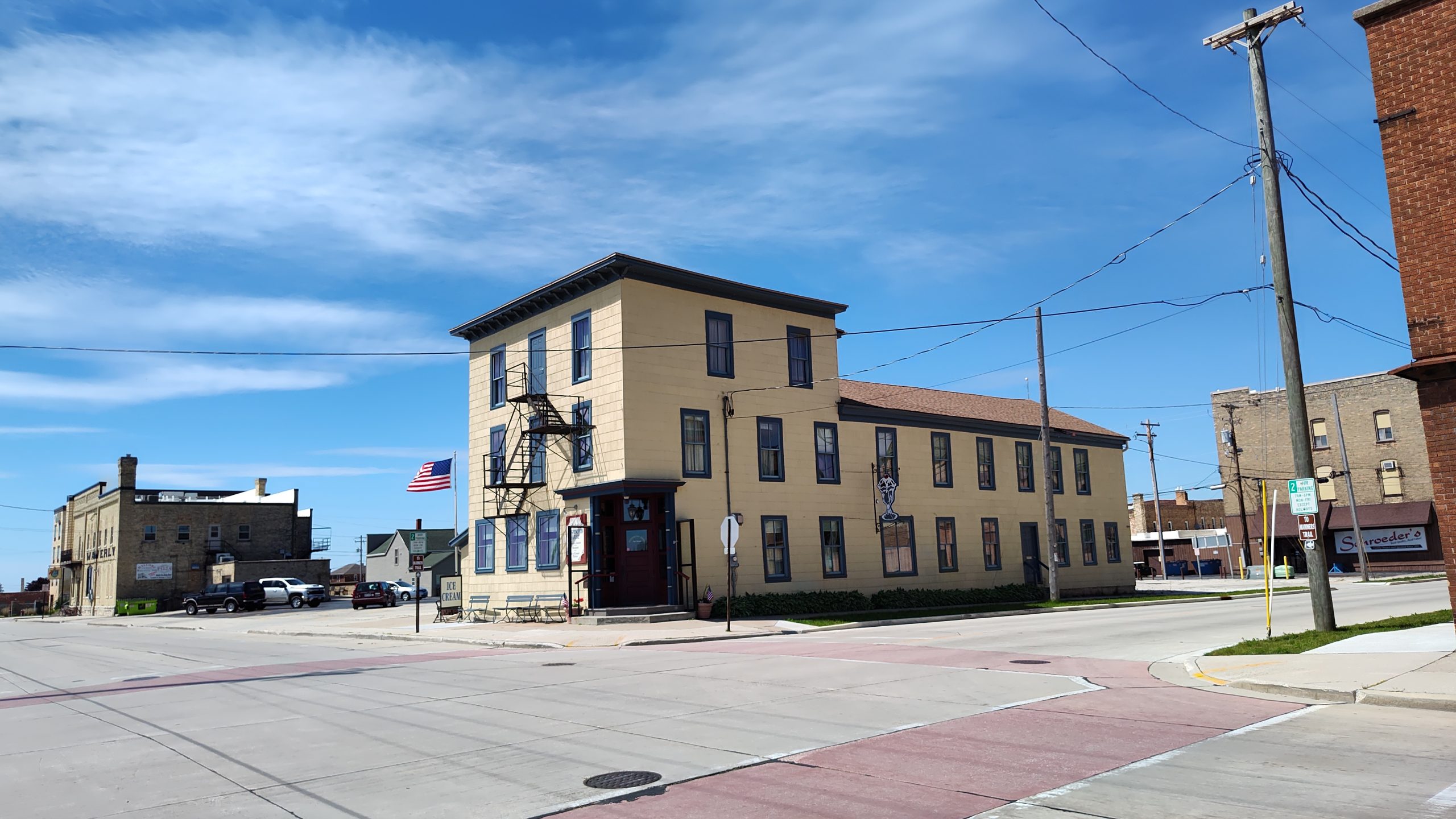
An addition has been built onto the front of the structure and the house at the back has been removed.
In 1927 Edward Berner closed his ice cream parlor. There is a replica of his establishment at the Washington House Hotel Museum in Two Rivers. Unfortunately, we didn’t have time to see the display as we were heading to the Badger car ferry, a few miles south in Manitowoc.
Edward Berner had passed away after aging 76 years. He has left a legacy. The 2,000 residents of Two Rivers smile proudly at their connection to the “Birthplace of the Ice Cream Sundae.”
This felt like an ending to this ice cream tale, but there has been continued controversy over the title of “The Birthplace of the Ice Cream Sundae” since the 1970’s.
Controversy
Well, as you know, this world thrives on controversy. Other cities have claims to being the first place to have served an ice cream sundae: New Orleans, Louisiana; Ithaca, New York; and Evanston, Illinois.
Ithaca, New York has displayed the strongest contention toward Two Rivers. This battle contains as many facets as there are flavors of ice cream.
Ithaca, New York
The Ithaca, New York “sundae story” had begun in the early 1890’s with Chester Platt, the owner of “Platt and Colt’s Soda Fountain.” Chester, a church treasurer, had served his local minister a dish of ice cream with drizzled cherry sauce and a candied cherry on top. As Chester Platt placed his concoction on the counter, all the customers’ eyes dazzled at this new style of dessert. Chester Platt had nodded knowingly and decided to advertise this ten cent treat in the Ithaca Daily Journal in the spring of 1892.
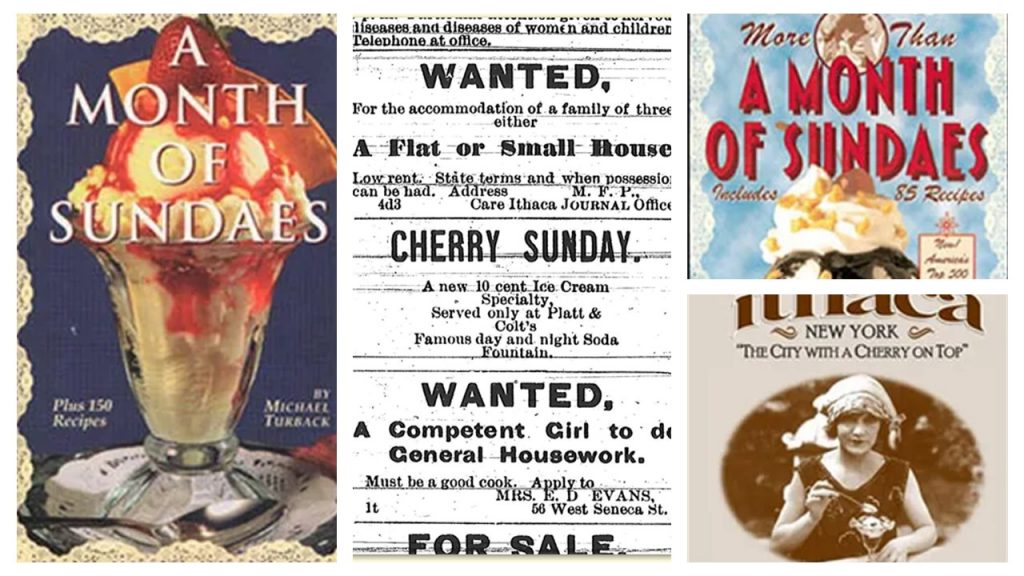
in the Ithaca Daily Journal which had been dated April 5, 1892. (center)
Michael Turback, a nationally known food historian and restaurant guru, has written several books about Ithaca’s connection to the cherry sundae. His books, “A Month of Sundaes,” shares recipes for ice cream. Turback has also penned an Ithaca, New York history book, “The City with a Cherry on Top.”
In 2006, two recently graduated high school students, who had been determined to prove that Ithaca had been the official birthplace of the ice cream sundae, began to collect hard evidence. In the library and museum archives they had found the newspaper ad (above), a letter from the shop’s clerk, a newspaper article featuring “Platt’s Sundays,” and a store ledger listing the necessary ingredients. This had provided a paper trail of written facts about Ithaca’s claim to being the “Birthplace of the Ice Cream Sundae.”
Evidence in Two Rivers
At the same time, Two Rivers scoured old newspaper editions. They had found an article where Seymour Althen had interviewed, Ed Berner, Ice Cream Parlor owner, in 1929. This had been forty years after the happenstance of the first sundae. Ed Berner had been quoted as he recalled the famous first “Sunday.”
“One night, Hallauer dropped in and ordered a dish of ice cream. As I was serving it, he spied a bottle of chocolate syrup on the back bar, which I used for making sodas. ‘Why don’t you put some of that chocolate on the ice cream?’ he asked. ‘You don’t want to ruin the flavor of the ice cream,’ I protested, but Hallauer answered ‘I’ll try anything once,’ and I poured on the chocolate. Hallauer liked it, and the ice cream sundae was born.”
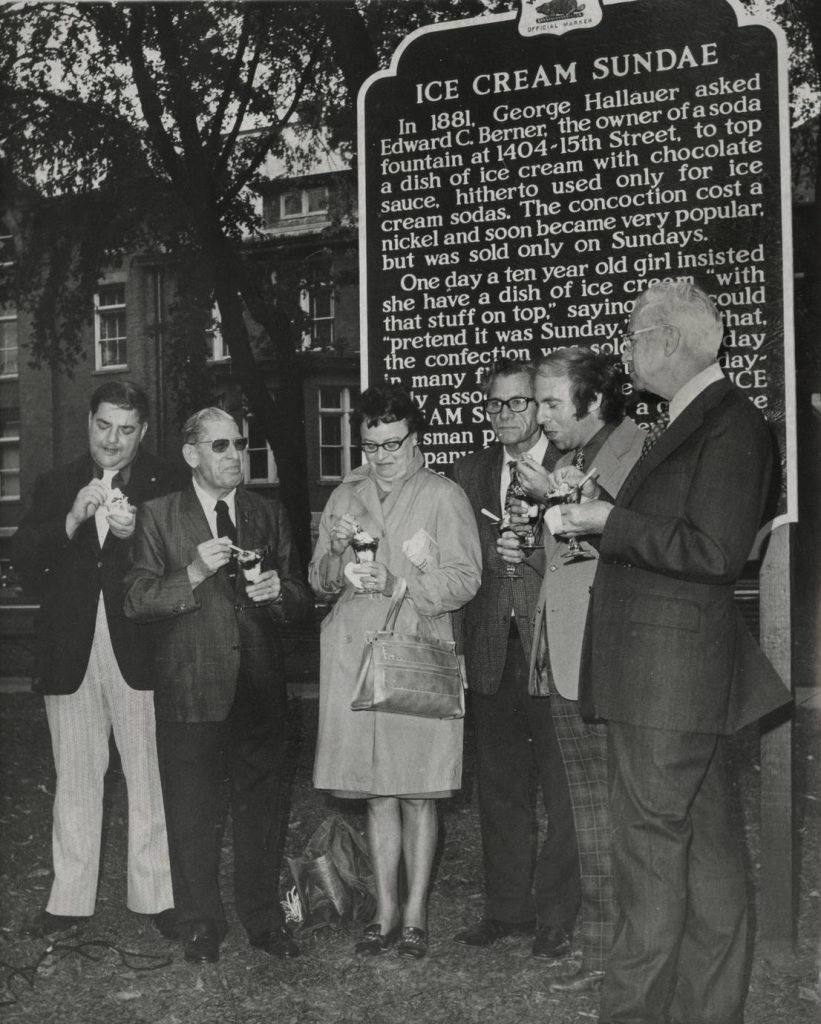
Tensions Rise – Ithaca vs. Two Rivers
Ithaca had doubted Two Rivers’ account, claiming Ed Berners would have only been 18 year old in 1881. It had seemed unlikely that Ed would have owned the ice cream parlor at such a young age.
Over the course of this dispute, both Ithaca and Two Rivers had purchased ads in each other’s local newspapers claiming their evidence. The community websites had include their own accounts of ice cream events and had picked apart the other city’s claims. Letters between the community leaders concerning the ownership of the title, “Birthplace of the Ice Cream Sundae” had been exchanged.
Not only that, but the citizens of each city had gotten involved, too. Two Rivers’ residents had sent a DVD of a community group singing a fight song about being the first to serve sundaes, sung to the tune
“On Wisconsin.” Two Rivers citizens had sent Ithaca’s mayor over 100 postcards. One had even been signed, “The Ghost of Ed Berners.”
In retaliation, Ithaca’s response had included a barber shop-style ballad, “Sundae Love,” created to the tune of “Moon River.” The lyrics are below:

This had been performed to the tune of “Moon River.”
By 2006 the controversy had reached the court system when Two Rivers had demanded that Ithaca “cease and desist” from its declaration as the first to serve a sundae.
Evanston, Illinois
As Two Rivers and Ithaca have been battling since the 1970’s, Evanston, Illinois has quietly claimed their ownership to the title of “The Birthplace of the Ice Cream Sundae,” first served at Garwood’s Drugstore.
In 1890, their story goes, the Methodist church had influenced a ban on selling ice cream sodas on Sundays, due to the “Blue Laws.” The clever, capitalist clerks had quickly concocted an idea to drizzle toppings over a scoop of ice cream in order to be compliant with the law, but still sell their wares. They called these, “Sunday Sodas.”
Richard Lloyd Jones, who’d grown up in Evanston at the time, had become a newspaper editor and had written, “Some ingenious confectioners and drug store operators in ‘Heavenston,’ obeying the law, served ice cream with the syrup of your choice without the soda. Thereby complying with the law. They did not serve ice cream sodas. They served sodas without soda on Sunday. This sodaless soda was the Sunday soda.” Jones had further surmised that college students could have introduced the concept of a sundae upon their return to their universities in New York and Two Rivers.
Ice Cream Sundaes
Well, that’s the ‘scoop’ on ice cream sundaes. Who knew there’d been such turmoil? I, for one, had no idea that ice cream sodas had once been outlawed on Sundays. I also never imagined that the title, “The Birthplace of the Ice Cream Sundae,” could cause a battle between Ithaca and Two Rivers. Now whenever we dip our spoons into an ice cream sundae, we can appreciate the layered history of our treat.
Resources:
U.S. Foods article
What’s Cooking, America article
Gale Academic One File article
Anne Funderburgh, historian and author of Sundae Best
Mental Floss article
Ithaca Ice Cream Sunday article
Evanston Round Table article



